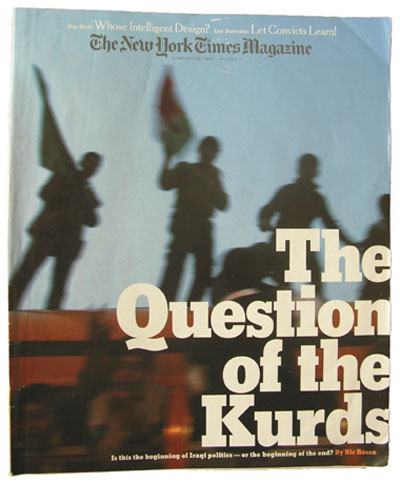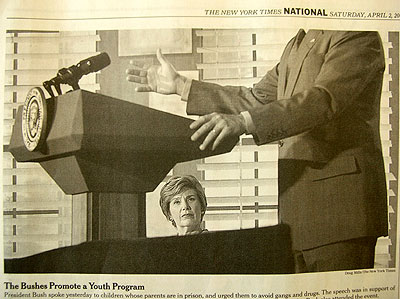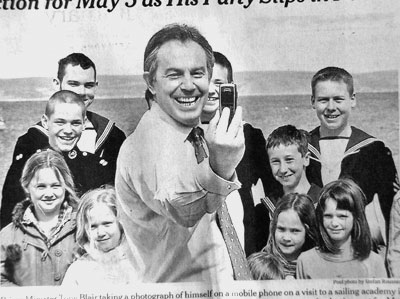Notes
Kurds on the Bus

I just don’t understand the Iraq coverage.
Perhaps all those images of stained fingers waving in the air created the sense that democracy was “a done deal.” For whatever reason, however, the press seems to have spent the last nine weeks back under the spell of “Mission Accomplished.”
I’m not saying there hasn’t been coverage. I’ve seen plenty of background pieces and soft profiles about training, rebuilding and the like. There have also been toothless reports of political doings. What I haven’t seen, however, is any political exposition. And I don’t just mean stories laying out the behind-the-scenes political battle over there. I’m also talking about the behind-the-scenes action over here. You don’t hear a word about the type and kind of leverage the American’s are applying. (Unless somebody wants to argue that the Administration, like they say, is just sitting on it’s hands and waiting for the dust to settle.)
The fact is, the Administration has been so effective in snuffing out questions about Iraq, even I’ve been suffering it. For months, I was all over the Iraq story. If you’ve been following the BAG, you might remember the nugget about our angry boys doing gang-style tagging (Our Gang – link); the election poster wars (Let’s See That Glue Stick, Soldier! – link); my series on Iraqi home invasions (Someone’s Been Sitting in my Chair …and They’ve Broken it all to Pieces! – link); and my pained status report on Fallujah (Something of an Update – link). Up until a few weeks ago, I was even keeping a close eye (Slowed to a Trickle – link) on the impending invasion of Ramadi by the so-named Coalition. (By the way, is El Salvador still on board?) To me, the Ramadi story was significant for two reasons. For one, Ramadi is about four times the size of Fallujah, where — if you remember — our Sunni “outreach program” didn’t go that well. Second, almost no one in the press was reporting on it. So what happened? Honestly, I don’t know. I’ve been under the spell.
But, back to the larger question, which is why critical Iraq coverage slipped into a holding pattern coincident with the deadlock over forming a new government. And, why the virtual lack of speculation in big media as to U.S. doings behind the scenes.
I can’t speculate why the press is looking the other way, but I have a theory as to why the Administration would be happy about it. I think the Administration is tacitly supporting the Kurds as they basically stonewall the political process to get their best deal. Besides angling to retain Kirkuk with its oil riches, the Kurds wish to maintain their militia and restore their property rights in the north. Reportedly, the Kurds had also been holding out for a more secular Shiite prime minister than the proposed candidate, Ibrahim al-Jaafari.
What I thought was interesting was Bush’s meeting with a group of Iraqi’s one week ago. With the exception of one Reuters story, most every report on it was cursory, with the usual boilerplate about how the President was optimistic about Iraq. I happened to listen to Bush’s comments, though, and they sounded more like a warning to Iraqi politicians to get on with it.
On it’s face, you might think that Bush was getting a little frustrated with the stalemate in Baghdad (and had some concern the press might actually start asking questions, as well), so he was applying targeted pressure to Iraqi negotiations. If this is true, however, there has got to be more of an agenda to it. Again, what is Bush’s angle? Could it have been, for example, that “getting on with it” effectively meant turning up the heat on the Shiites to give in to the Kurds?
As you can tell, this cover of the NYT Magazine is a little beaten up. That’s because I’ve been carrying it around since it came out, February 20th. When I first saw it, I thought it evoked something fundamental about the political situation. But I wasn’t sure what.
Now, though, I have a stronger sense about it. Obviously, it’s about shadows. In spite of the new so-called democracy, and in spite of the seating of the new assembly, and in spite of scattered attempts to open the process, Iraq is still operating in the shadows. (Which probably wouldn’t be that big a point except for the fact the Administration stakes its fame on the opposite.) The current political process in Iraq is a study in silhouette. You could look at any of the major players through this metaphor. If this cover can be taken as portentous, however, there are obvious signs of Kurdish ascendency.
Take a close look at the flag. The faces may be monochrome, but not the colors they fly.
Notice the relation of the figures to the ground. (Men are either standing on or behind a school bus. In the right foreground, one person is actually scaling it.) They hold the higher ground.
At the lower left, there appear to be children’s faces, with one arm holding up a victory sign. Maybe it’s just my association, but the image feels brash. These guys are opportunistic, in motion, pressing the cause. Behind the scenes, you can imagine there is a lot of showboating going on.
(image : Lynsey Addario/Corbis in The New York Times Magazine)


Reactions
Comments Powered by Disqus